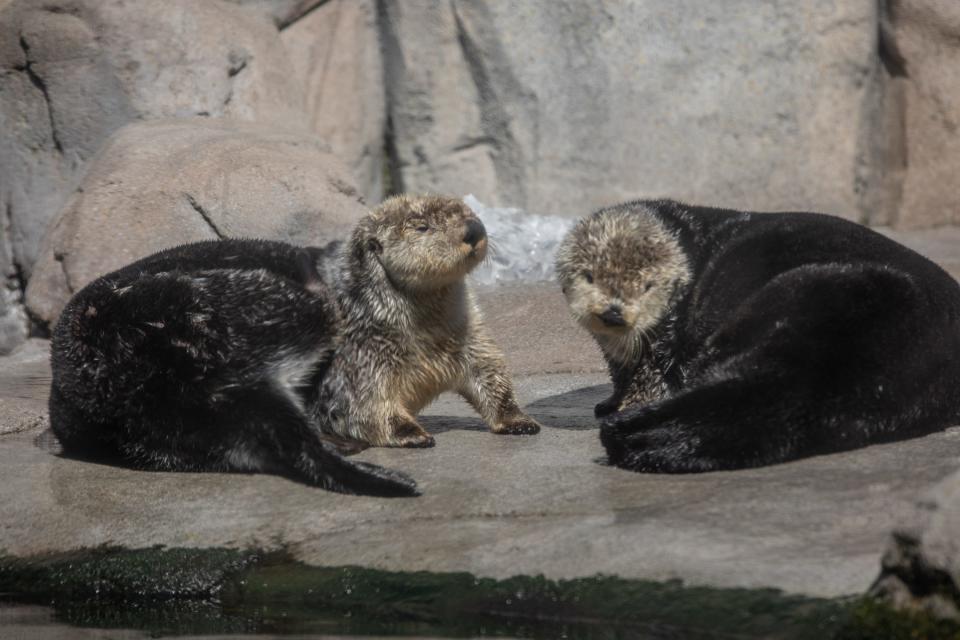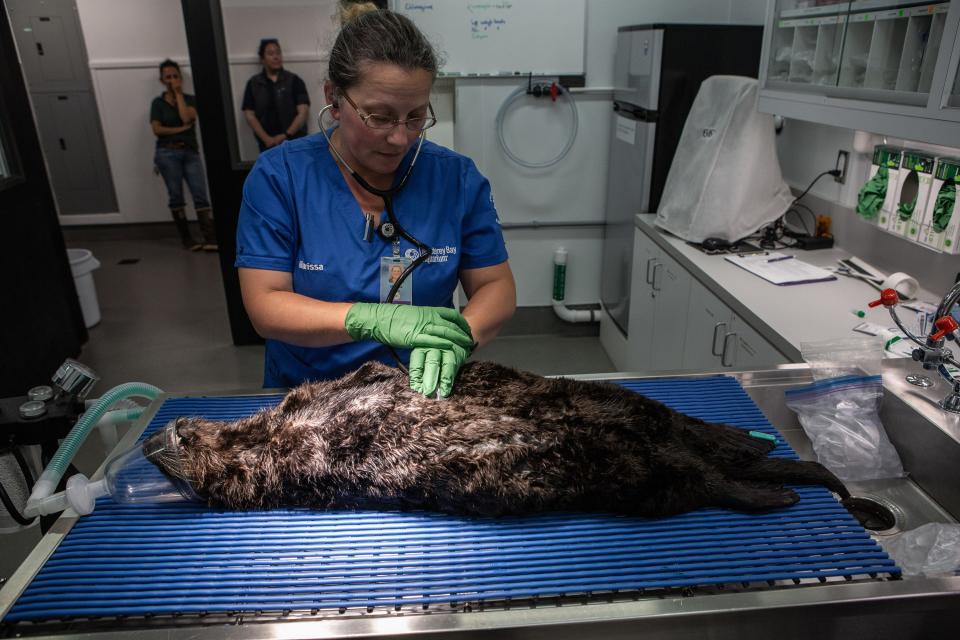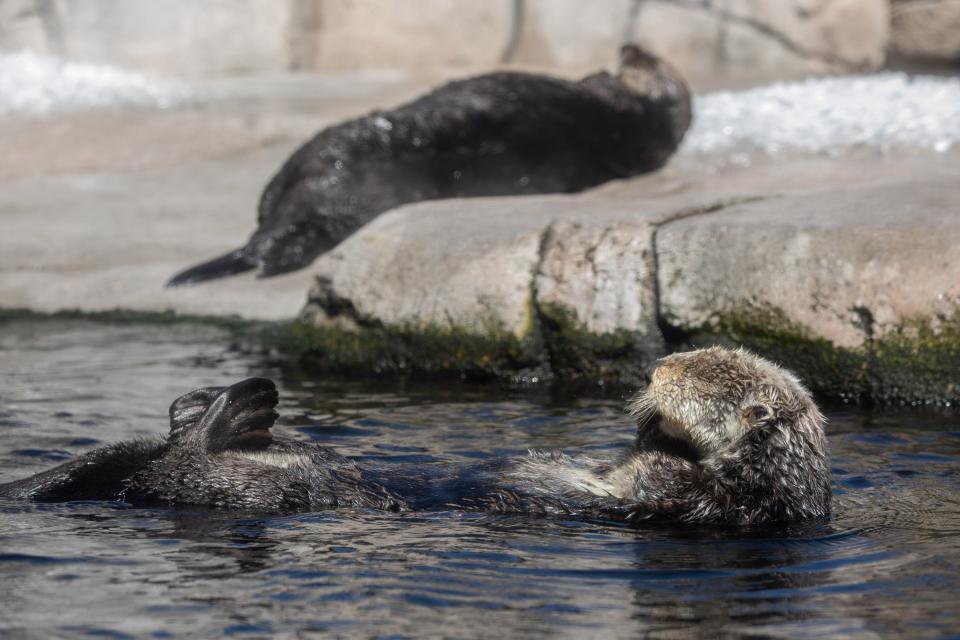Not just a pretty face: Female sea otters raise orphaned pups at Monterey Bay Aquarium
MONTEREY, Calif. – The sea otter exhibit has long made for a popular attraction at the Monterey Bay Aquarium as visitors are inevitably charmed by the sight of the furry creatures swimming on their backs.
Some of those same adorable otters may also perform a much more crucial role than merely looking cute – raising orphaned pups and preparing them to be returned to the wild.
Since 2002, the renowned aquarium has conducted a unique program based on rescuing stranded baby otters, matching them with female surrogates and eventually releasing them into a coastal estuary. The success of the endeavor is documented in a study published Monday in Oryx – The International Journal of Conservation.
During the 15-year study, the aquarium’s team released 37 rescued and surrogate-raised young otters into an inlet in central California and found they survived and reproduced at rates comparable to their kin raised in the wild. Researchers also discovered the otters from the program and their descendants accounted for more than 50% of the population growth in the once-degraded ecosystem, which regained vitality.
“This is exactly what we want. We want them to be wild otters,’’ said Kyle S. Van Houtan, the aquarium’s chief scientist. “We want these orphan pups to go back in the wild and contribute to the population and perform all those ecosystem functions that are so helpful to the kelp and the eel grass estuaries.’’

As a keystone species that feeds on sea urchins and other plant-eating marine life, otters are critical to the health of ecosystems like kelp forests, which absorb large amounts of carbon from the atmosphere and release oxygen.
The surrogacy program, if expanded to other facilities, has the potential to help restore the population of a marine mammal that was nearly hunted into extinction for its fur in the 18th and 19th centuries, until a multinational treaty in 1911 banned otter harvesting.
Their challenge: Threatened sea otters struggle to expand range
Southern sea otters, a subspecies also known as California sea otters, have been listed as threatened since 1977. Their population has grown from an estimated 50 to about 3,000, but they’re mostly concentrated in the central California coast, especially Monterey Bay. Their historical range extends from Alaska to Baja California in Mexico.
While the aquarium and other enthusiasts celebrate Sea Otter Awareness Week, which began Sunday, Karl Mayer and his cohorts can look back in satisfaction at the evolution of a program that began in somewhat serendipitous fashion.
Mayer, the sea otter field response coordinator and lead author of the study, had toyed with the idea of surrogacy for a while, because rescued pups nursed back to health by humans became too habituated to them and were ill-equipped to return to the wild.

“Sea otters are a bit unique because they’re in a situation where the role of the mother is completely vital for whether the pup will wind up surviving in the wild after it’s weaned,’’ said Mayer, adding that the process takes at least six months. “It’s a very steep learning curve for sea otter pups.’’
In the early 2000s, the aquarium acquired two female otters that could not be released back to nature, and one of them was pregnant and had a stillborn baby. Within 24 hours, a rescued pup arrived, and when placed in the same holding tank, was promptly “adopted’’ by the female that had lost her young.
Mayer’s team later matched the other female with an orphaned pup and noticed a similar bond soon developed, and that has been the case in more than 80% of the matches.
The results were a bit surprising because those types of “adoptions’’ are rare among otters in the wild, although they do happen with other mammals. The one proviso was the infant otters had to be at least eight weeks in age, old enough to retrieve food, because the females were not lactating in any significant way.

“The behaviors we start to see are, the female will grab the pup and begin to sniff it and explore, begins to tow the pup around on her chest,’’ Mayer said. “Eventually we may start to see the female sharing food with the pup. They’ll sleep together. The female will behave very protectively, and ultimately we start to see in most cases the pups attempting to nurse on the female.’’
Because sea otters have an exceedingly fast metabolism and need to eat 25%-30% of their body weight every day, it’s essential for them to learn foraging skills at an early age. They also lack blubber, so mothers preen the pups’ fur and keep it fluffy so they stay warm.
Sea exploration: The 10 best dive sites in the Caribbean include wreckage, marine life and underwater wonder
The Monterey Bay Aquarium, which draws about 1.8 million visitors annually and tries to promote ocean conservation, rescues 12-15 young otters a year but has room to raise only five at a time through the surrogacy program. With 15 years’ worth of tracking data available to share, its officials hope other aquariums and zoos will implement this approach and, ideally, help sea otter populations expand to their historical range.
There are a number of obstacles to that goal, mainly the presence of attacking white sharks in those waters, along with the danger of oil spills and a decrease in kelp forests attributed to climate change.
But the results of the surrogacy program serve as encouragement for those who are fond of the fuzzy critters, be it as visitors or marine scientists.
“People come from all over the world to the Monterey Bay Aquarium for a great experience and to see beautiful things in the ocean that they might never get to see in person, and that’s pretty universally understood,’’ Van Houtan said. “But there’s also a lot of science going on behind that here.’’
This article originally appeared on USA TODAY: Sea otters: Monterey Bay Aquarium raising orphaned pups

